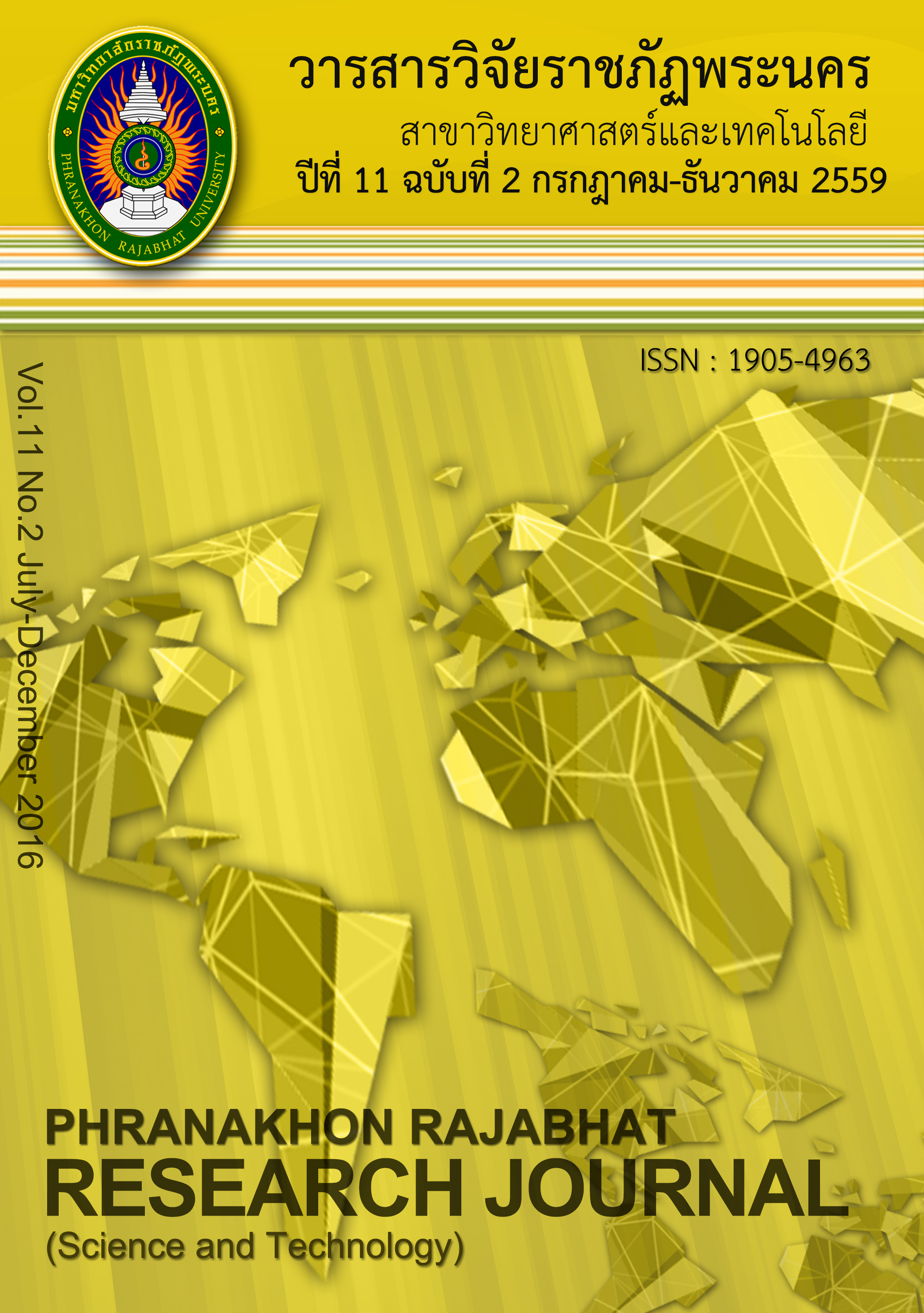การถ่ายทอดนวัตกรรมชุมชนในการจัดการน้ำเสียที่เหมาะสมกับภูมินิเวศสู่เยาวชน THE TRANSFER OF THE COMMUNITY INNOVATION IN MANAGING WASTEWATER TREATMENT APPROPRIATE FOR THE GEOGRAPHIC ECOSYSTEM FROM ADULTS TO YOUTH ไพโรจน์ ศาสนวิสุทธิ์1 สุวารีย์ ศรีปูณะ2 จินต
Keywords:
นวัตกรรมชุมชนม, การจัดการน้ำเสีย, ภูมินิเวศ, การถ่ายทอด, Community Innovation, Management of Wastewater Treatment, Geographic Ecosystem, TransferAbstract
การถ่ายทอดนวัตกรรมชุมชนในการจัดการน้ำเสียที่เหมาะสมกับภูมินิเวศสู่เยาวชน
บทคัดย่อ
ปัญหาน้ำเสียในแม่น้ำลำคลองมีต้นเหตุมาจากการปล่อยน้ำเสียของครัวเรือน การแก้ไขให้ยั่งยืนจากต้นทางควรใช้นวัตกรรมที่เหมาะสมกับภูมินิเวศที่ชุมชนพัฒนาขึ้นและถ่ายทอดสู่คนรุ่นใหม่ต่อไป การวิจัยครั้งนี้จึงมีวัตถุประสงค์เพื่อศึกษารูปแบบนวัตกรรมชุมชนในการจัดการน้ำเสียที่เหมาะสมกับภูมินิเวศ ความต้องการถ่ายทอดนวัตกรรมชุมชน วิธีการถ่ายทอดนวัตกรรมชุมชนสู่เยาวชน และประเมินความพึงพอใจของเยาวชนต่อการจัดการถ่ายทอดนวัตกรรมชุมชน พื้นที่วิจัยได้แก่ ชุมชนในเครือข่ายสิ่งแวดล้อมจังหวัดปทุมธานีรวม 5 ชุมชนที่อยู่ริมคลองสาขาของแม่น้ำเจ้าพระยา ประกอบด้วย ชุมชนบางปรอก ชุมชนบ้านคลองรังสิต ชุมชนสร้างสรรค์นครรังสิต ชุมชนบ้านปากคลองบางโพธิ์เหนือ และชุมชนบ้านศาลาแดงเหนือ กลุ่มเป้าหมาย 2 กลุ่มรวม 113 คน ได้แก่ 1) ปราชญ์ชุมชนด้านนวัตกรรมการจัดการน้ำเสีย ผู้นำชุมชน ตัวแทนครัวเรือน ประธานและกรรมการเครือข่ายสิ่งแวดล้อมจังหวัดปทุมธานี จำนวน 50 คน 2) เยาวชน จำนวน 63 คน เก็บข้อมูลโดยใช้แบบสัมภาษณ์ ประเด็นคำถาม แบบบันทึก การปฏิบัติการ และแบบสอบถาม วิเคราะห์ข้อมูลโดยการวิเคราะห์เนื้อหา และใช้สถิติ ค่าร้อยละ ค่าเฉลี่ย ส่วนเบี่ยงเบนมาตรฐาน
ผลการศึกษา พบว่า ชุมชนริมคลองสาขาของแม่น้ำเจ้าพระยา ได้ร่วมกันหาวิธีลดปัญหาน้ำเสียจากครัวเรือน โดยการสร้างถังกรองไขมันใช้ในชุมชนมานานกว่า 100 ปี จนปี 2547 ได้พัฒนาเป็นถังบำบัดน้ำเสีย ซึ่งเครือข่ายสิ่งแวดล้อมจังหวัดปทุมธานีได้ยกย่องให้เป็นนวัตกรรมชุมชน โดยมีรูปแบบของถังบำบัดน้ำเสียที่สร้างขึ้นทั้งสิ้น 16 รูปแบบ เป็นรูปแบบดั้งเดิม 10 รูปแบบ รูปแบบใหม่ 6 รูปแบบ โดยรูปแบบที่นิยมสร้างในปัจจุบันมี 2 รูปแบบ คือ แบบยั่งยืน 2 ถัง และแบบยั่งยืน 3 ถัง ลักษณะโดยรวมของถังบำบัดน้ำเสียมีการวางถังซีเมนต์เพื่อเป็นถังกรอง 3 แบบ คือ แบบฝังดิน แบบบนดิน และแบบผสม โดยเลือกที่ตั้งแตกต่างกันตามลักษณะภูมินิเวศ มีวัสดุกรองเป็นชั้นๆ ลำดับจากล่างขึ้นบนได้แก่ อิฐมอญ ถ่านไม้ หินเกล็ด อิฐมอญ ชุมชนและเครือข่ายเห็นความจำเป็นที่ต้องแก้ปัญหาน้ำเสียให้ยั่งยืน จึงต้องการถ่ายทอดนวัตกรรมสู่เยาวชนซึ่งเป็นคนรุ่นใหม่ได้เห็นคุณค่าและสามารถใช้ถังบำบัดน้ำเสียที่เป็นนวัตกรรมชุมชนนี้สร้างสิ่งแวดล้อมที่ดีของชุมชนต่อไป การจัดการถ่ายทอดได้ใช้ TCI 1234 Model โดยใช้สัดส่วนการถ่ายทอด 1:2:3:4 ระหว่างการสร้างความรู้ : ความตระหนัก : ทักษะ : ค่านิยมทางสิ่งแวดล้อม โดยวิธีการบรรยาย ให้ชมวิดีทัศน์ เรียนรู้จากตัวอย่างจริงในชุมชน และฝึกปฏิบัติ และพัฒนาต่อยอดนวัตกรรมชุมชน ผลการถ่ายทอดเยาวชนมีความพึงพอใจในระดับมากที่สุด และเกิดผลต่อเนื่องโดยเยาวชนได้ร่วมกันวาดภาพศิลปะบนถังกรองน้ำเสียจนเกิดสุนทรียภาพสร้างสิ่งแวดล้อมที่ดีให้ชุมชน ได้มีการทดลองเพิ่มชั้นการกรองน้ำเสียด้วยกาบมะพร้าว และร่วมกันจัดตั้งกลุ่มเยาวชนแกนนำให้ทำหน้าที่ขยายผลการจัดการน้ำเสียจากครัวเรือนด้วยนวัตกรรมชุมชนสู่ชุมชนอื่นต่อไป
THE TRANSFER OF THE COMMUNITY INNOVATION IN MANAGING WASTEWATER TREATMENT APPROPRIATE FOR THE GEOGRAPHIC ECOSYSTEM FROM ADULTS TO YOUTH
Abstract
The problem of waste water in the waterways usually originated from the wastewater released from the households. In terms of the sustainable solution for the wastewater treatment, the community had to transfer the knowledge of the innovative wastewater treatment appropriate for the Geographic Ecosystem from adults to youth. The objectives of this research were to 1) analyze the community innovative model of managing wastewater treatment appropriate for the Geographic Ecosystem, 2) analyze the need of transfer the community innovative wastewater treatment management, 3) study the method of transfer the community innovation in managing the appropriate wastewater treatment from adults to youth, and 4) evaluate the youth satisfaction toward the transferring innovation management to youth. The research target areas were five communities from the environmental network of Pathum Thani Province located along the branch canals of the Chao Phraya River. These communities were: Bang Prok Community; Ban Khlong Rangsit Community; Sangsannakhonrangsit Community; Ban Pak Khlong Bangpho Nua Community; and Ban Sala Daeng Nua Community. The samples of this research were the total of one hundred and eighteen community peoples and were consisted of two groups: 1) forty-five community people, these were local philosophers in innovative wastewater treatment; community leaders; household representatives; president and the committee of environmental network of Pathum Thani Province. 2) sixty-three youths. The research methodology used was structured interviews. The research tools were the interview form, structured interviewed questions; interview log; performance log; and a set of questionnaire. The data received were analyzed by content and by percentage, arithmetic mean, and standard deviation.
The results of the study were the communities located along the branch canals of the Chao Phraya River participated in managing the wastewater treatment by building the grease tanks in the communities for more than one hundred years. In 2004 (B.E. 2547), the grease tanks were developed into the wastewater treatment tanks, which received the recognition from the environmental network, Pathum Thani Province as the community innovative invention. There were sixteen models of the community innovation in wastewater treatment management, these were; ten traditional models and six new models. The overall distinctive features of the invention were three cement tanks set at three different places according to the Geographic Ecosystem, these were underground, on-ground, and the mixed. Inside the tanks consisted of many layers of filter starting from brick, charcoal and ending up with another layer of brick at the top. The communities and the network committee perceived the necessity to manage the wastewater treatment properly and sustainably. They wished to transfer their innovative invention to the youth to perceive the value and able to use the invention properly. For this reason, they arranged the community innovative transfer program (TCI 1234 Model). The transmission ratio of 1: 2: 3: 4 between knowledge creation: awareness: skills: environmental values by lecturing, watching VDO, learning from the real situation in the community, practicing the innovative construction. As for the results of youth evaluation, it was found that the majority of the youth were satisfied with this knowledge transfer project at the highest level. The youth also got involved in waste water treatment tank painting activity to make the aesthetics atmosphere in the community. Moreover, the coconut spathe was used as a new layer in waste water treatment tank. In addition, the youth leaders association was founded for dissemination of the community innovation to other communities.
Downloads
Published
Issue
Section
License
โปรดกรอกเอกสารและลงนาม "หนังสือรับรองให้ตีพิมพ์บทความในวารสารวิจัยมหาวิทยาลัยราชภัฏพระนคร สาขาวิทยาศาสตร์และเทคโนโลยี" ก่อนการตีพิมพ์




